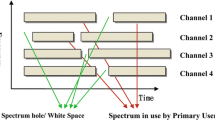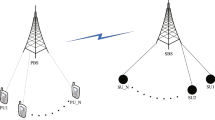Abstract
We propose a reputation-based cooperative spectrum sensing scheme in cognitive radio (CR) networks to solve the uncertainty resulting from the multipath fading and shadowing effect. In the proposed scheme, each cooperative CR user has a reputation degree that is initialized and adjusted by the central controller, and used to weight the sensing result from the corresponding CR user in the linear fusion process at the central controller. A simple method for adjusting the reputation degree of CR users is also presented. We analyzed and evaluated the detection performance of the reputation-based cooperative spectrum sensing scheme. Simulation results showed that our proposed scheme alleviates the problem of corrupted detection resulting from destructive channel conditions between the primary transmitter and the CR user. The performance of our proposed scheme was improved compared to the average-based linear cooperation scheme, and was similar to that of the optimal linear cooperation scheme with feasible computational complexity. Moreover, our proposed scheme does not require knowledge of channel statistics.
Similar content being viewed by others
References
Akyildiz, I.F., Lee, W.Y., Vuran, C., Mohanty, S., 2008. A survey on spectrum management in cognitive radio networks. IEEE Commun. Mag., 46(4):40–47. [doi:10.1109/MCOM.2008.4481339]
Cabric, D., Mishra, S.M., Brodersen, R.W., 2004. Implementation Issues in Spectrum Sensing for Cognitive Radios. 38th Asilomar Conf. on Signals, Systems and Computers, p.772–776. [doi:10.1109/ACSSC.2004.1399240]
Cabric, D., Thachenko, A., Brodersen, R.W., 2006. Experimental Study of Spectrum Sensing Based on Energy Detection and Network Cooperation. ACM 1st Int. Workshop on Technology and Policy for Access Spectrum, Article 12. [doi:10.1145/1234388.1234400]
Enserink, S., Cochran, D., 1994. A Cyclostationary Feature Detector. 28th Asilomar Conf. on Signals, Systems and Computers, p.806–810. [doi:10.1109/ACSSC.1994.471573]
Ganesan, G., Li, Y., 2007a. Cooperative spectrum sensing in cognitive radio, Part I: two user networks. IEEE Trans. Wirel. Commun., 6(6):2204–2213. [doi:10.1109/TWC.2007.05775]
Ganesan, G., Li, Y., 2007b. Cooperative spectrum sensing in cognitive radio, Part II: multiuser networks. IEEE Trans. Wirel. Commun., 6(6):2214–2222. [doi:10.1109/TWC.2007.05776]
Gendenko, B.V., Kolmogorov, A.N., 1954. Limit Distributions for Sums of Independent Random Variables. Springer-Verlag, New York, p.94–124.
Ghasemi, A., Sousa, E.S., 2008. Spectrum sensing in cognitive radio networks: requirements, challenges and design trade-offs. IEEE Commun. Mag., 46(4):32–39. [doi:10.1109/MCOM.2008.4481338]
Hong, L., Ma, J., Xu, F., Li, S., Zhou, Z., 2008. Optimization of Collaborative Spectrum Sensing for Cognitive Radio. IEEE Int. Conf. on Networking, Sensing and Control, p.1730–1733. [doi:10.1109/ICNSC.2008.4525502]
Kay, S.M., 1998. Fundamentals of Statistical Signal Processing: Detection Theory. Prentice-Hall, Englewood Cliffs, NJ, p.60–93.
Ma, J., Li, Y., 2007. Soft Combination and Detection for Cooperative Spectrum Sensing in Cognitive Radio Networks. IEEE Global Communications Conf., p.3139–3143. [doi:10.1109/GLOCOM.2007.594]
Mishra, S.M., Sahai, A., Brodersen, R.W., 2006. Cooperative Sensing Among Cognitive Radios. Proc. IEEE Int. Conf. on Communications, p.1658–1663. [doi:10.1109/ICC.2006.254957]
Quan, Z., Cui, S., Sayed, A.H., 2008a. Optimal linear cooperation for spectrum sensing in cognitive radio networks. IEEE J. Sel. Topics Signal Process., 2(1):28–40. [doi:10.1109/JSTSP.2007.914882]
Quan, Z., Cui, S.G., Poor, H., Sayed, A.H., 2008b. Collaborative wideband sensing for cognitive radios. IEEE Signal Process. Mag., 25(6):60–73. [doi:10.1109/MSP.2008.929296]
Quan, Z., Cui, S., Sayed, A.H., Poor, H.V., 2009. Optimal multiband joint detection for spectrum sensing in cognitive radio networks. IEEE Trans. Signal Process., 57(3):1128–1140. [doi:10.1109/TSP.2008.2008540]
Sun, C., Zhang, W., Letaief, K.B., 2007. Cooperative Spectrum Sensing for Cognitive Radios under Bandwidth Constraints. IEEE Wireless Communications & Networking Conf., p.1–5. [doi:10.1109/WCNC.2007.6]
Unnikrishnan, J., Veeravalli, V.V., 2008. Cooperative sensing for primary detection in cognitive radio. IEEE J. Sel. Topics Signal Process., 2(1):18–27. [doi:10.1109/JSTSP.2007.914880]
Zhang, W., Mallik, R.K., Letaief, K.B., 2008. Cooperative Spectrum Sensing Optimization in Cognitive Radio Networks. Proc. IEEE Int. Conf. on Communications, p.3411–3415. [doi:10.1109/ICC.2008.641]
Author information
Authors and Affiliations
Corresponding author
Additional information
Project supported by the National Natural Science Foundation of China (No. 60772093), the National Basic Research Program of China (No. 2009CB320405), and the Zhejiang Provincial Foundation for Returnees
Rights and permissions
About this article
Cite this article
Chen, Hf., Jin, X. & Xie, L. Reputation-based linear cooperation for spectrum sensing in cognitive radio networks. J. Zhejiang Univ. Sci. A 10, 1688–1695 (2009). https://doi.org/10.1631/jzus.A0820870
Received:
Revised:
Published:
Issue Date:
DOI: https://doi.org/10.1631/jzus.A0820870




